I have been told over and over by native Taiwanese and twitterpated Taiwanese tourists that I simply HAVE to go to Taiwan, that it is nothing like China, or possibly it was everything I love about China with none of the Communism. It’s so close to Korea, the flights are easy, but the weather is hard. In January 2019 I had a spare 2 weeks before I would meet my friend for our whirlwind Middle East tour. It seemed like a great chance to finally see the Ilha Formosa. The rest of the holiday that winter was so much, I forgot I didn’t write about Taiwan until my Facebook Memories started popping up this January. Faced with an unexpected rainy week on my holidays in “sunny” Spain, it seems like an opportunity to fix that.
I went to three main cities: Taipei, Taichung, and Kaohsiung. I ate more delicious food than I thought could exist on such a tiny island, and I enjoyed local sightseeing, temples, and natural wonders. In the first post, I’m going to give a little historical context and then talk about the natural beauty and the temples I visited. In the second post, I’ll share my more urban tourist experiences and saving the best for last, the food.
A Very Very Brief History
I used to live and work in mainland China (in Jinan, and later Yanjiao, a small town outside Beijing), plus I studied Chinese history, culture and language in university. I knew Taiwan was different, but I didn’t really understand how much.
Taiwan separated from China when the Kuo Min Tang fled there after Mao and the Communists took over mainland China in 1949. China under the KMT government was part of the Allies in WWII. We gave them money to fight the Japanese, but they ended up using it to fight the communists, and still lost. Most of the Western World didn’t recognize the communist government of China until the 1970’s. We were busily still supporting the Taiwanese government as the rightful government of all China.
A few countries at a time slowly came to realize that the communists weren’t going anywhere, and then Nixon had his famous visit to Beijing to stand on the fake Great Wall and show solidarity and that was pretty much it. Since then, China insists that Taiwan is a part of China and everyone just sort of humors them. We make separate treaties and trade agreements, plus Taiwan has a different language, flag, currency, government and legal system from mainland China…. but, ONE COUNTRY! (says China)… Taiwan is starting to disagree.
Of course Taiwan has a strong Chinese identity and history, but it diverges sharply at 1949. At the end of the Civil War, the KMT retreated to Taiwan and the Communist (Mao) government claimed the mainland. Mao’s government worked hard to erase a lot of history in order to position the Party at the top and center of all life in China. It was huge disaster and tens of millions of people died from persecution and starvation. Plus temples and relics were destroyed or stripped of decoration and re-purposed as Party business community halls. Some time in the 80s, the government went “oops” maybe we need history after all, and started rebuilding both physically and narratively. Therefore almost everything you see nowadays in China is a reconstruction, and the few practicing monks and nuns in the temples are there under very strict observation because someone told China that civilized countries don’t murder all their religious leaders. (most of the literature on this is academic research and NOT readily accessible in Wikipedia, you can take my word or you can go ask a Chinese Studies scholar). Although, now with Hu… who knows?
Taiwan, on the other hand, continued the Nationalist traditions that were started in the 1911 Xinhai Revolution that finally eliminated the monarchy and established a “people’s” government… although arguably back to the Boxer Rebellion because everyone was so fed up at those Royals supplanting Traditional Chinese Culture™ with Western European goods and values… and opium…The point is that the KMT were basically in favor of traditional Chinese culture, where the Communists were pretty opposed. So while mainland China went through this holocaust level cultural purge (The “Great Leap Forward” followed by what is still referred to as the “Cultural Revolution” which makes it sounds like hippies dropping acid and doing free love), Taiwan and other Chinese communities in Asia (Malaysia makes this super ovbs, too) were continuing to move forward with a more normal level of cultural changes influenced by post colonialism, globalization, and technology just like everyone else.
2000 years of shared history, followed by 60 very divergent years brings us to the ‘same but different’ cultures of mainland China and Taiwan. So while China firewalls out anything it doesn’t like and creates its own online reality, arrests anyone who dissents, and sends religious or sexual minorities to reeducation camps, prisons, or organ harvesting factories, Taiwan is a proud democracy that legalized same sex marriage last year. While that sounds a little behind to most westerners, its stunningly progressive for Asia. They were actually the first country to do it.
Lastly, a quick note on the spelling. Mainland China adopted a variety of romanization (“roman” letters, like the ones you are reading now) called “pinyin” while Taiwan used the older form Wade-Giles. Some brief examples (minus tone marker): Beijing /Peiking, Gaoxiong /Kaohsiung, Deng Xiaoping /Teng Hsiao-p’ing, Guomindang /Kuomintang. Although now-a-days a lot of things in Taiwan are romanized in Pinyin, those places which were internationally codified with Wade-Giles spelling still remain. Pronunciation remains a challenge for those who have not studied the language because neither system is intuitive for English speakers. (try typing the pinyin spelling into Google translate to listen).
Natural Wonders:
Taipei:
Yehliu Geopark 野柳地質公園
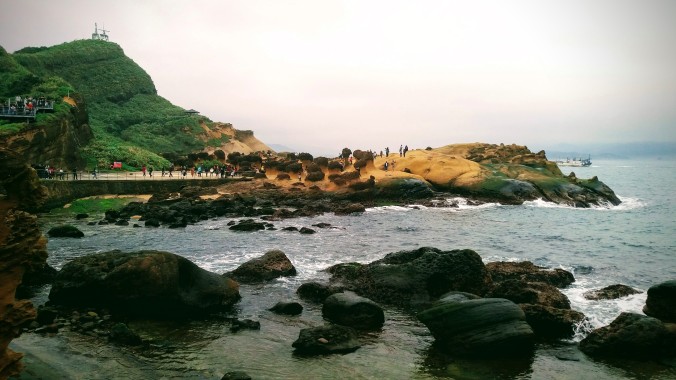
This was part of a package bus tour I took, but honestly, if I ever go back to Taipei, I want to take the public bus out here and spend a whole day at this park. This website has some very nice English language explanations about the rock formations and erosion patters, if you’re curious.
I do love the science, but I have to say that I, like most of the visitors, was more enchanted by the fairy-tale like shapes that these rocks have come to embody. When I arrived, I got a little pamphlet showing the most famous formations. It was a little bit like a scavenger hunt trying to find them all, and I kept getting distracted by not at all famous, but still amazingly beautiful rock formations like joints and fossils all around.
The most famous rock is the Queen’s Head, which you may have seen on listicles of “cool things to visit”. The line to get a photo from the best angle was insane, and because I was in a tour group, I had to choose between standing in line for the famous rock, or going to see all the others. Still, I got a glimpse of Queens Head rock from the queen angle by wheedling past the line creatively (really the line is for people who want to pose with it, you are allowed to take a picture from anywhere). In case you can’t tell, it’s the one in the background that looks sort of like woman’s head with an updo or royal headdress.
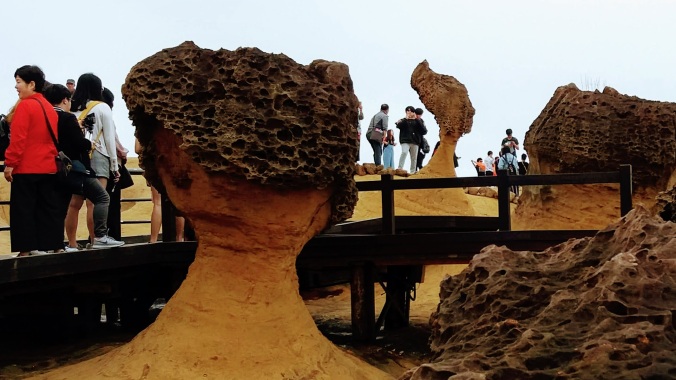
The park is well aware the Queen is their biggest draw, and that it is eroding a little more every year. It won’t be long before her neck erodes entirely and she becomes Marie Antoinette instead. To maintain tourism, the park has named a new “Cute Princess Rock” which is shaping up to become the main attraction when the old queen dies.
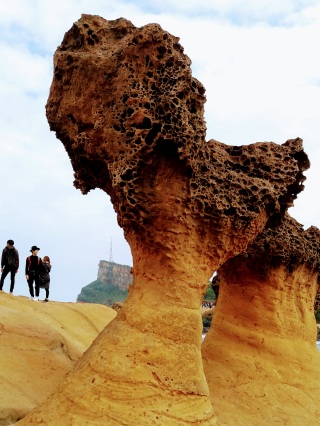
Other rock formations I found include the Elephant Rock & The Pineapple Bread Rock. Pineapple bread is just cut to look like a pineapple.It doesn’t taste like and isn’t made with pineapple (unlike pineapple cake which is, but looks like tofu squares).
One little island turned out to contain at least 3 of the targets: the peanut rock (far left), the fairy shoe (about 3/4 on the upper right, kind of looks like a sandal) and the pearl, or globe (far right, the lower sphere, yeah, I know there’s like 4).
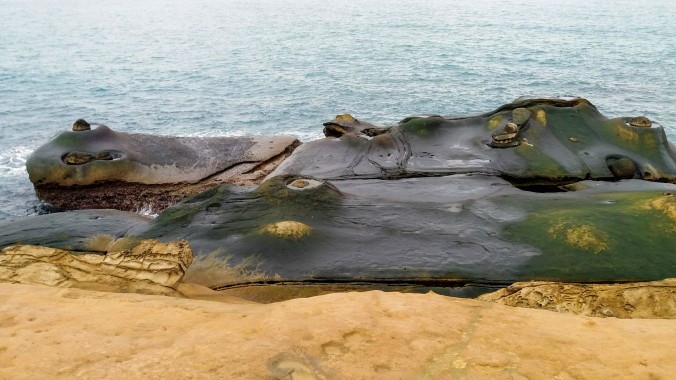
Our tour guide challenged us to find a particular rock and take a photo of it that matched the angle in the brochure. The angles of these rock formations matters quite a bit. The queen doesn’t look like a queen from any other angle (see below). In this case it was a gorilla, and you had to walk all the way around to the side facing away from the path to see the illusion. Most people were taking photos through the hole in the rock without ever realizing they were at the gorilla! (I won the scavenger hunt).
Looking at the brochure and the website, it’s painfully obvious I saw only a tiny part of the park, and I had a very limited time to try and find and appreciate these unique formations. I’m glad I had the opportunity, but a full day return is on the top of my list for a second visit to Taipei (right behind the food).
Shifen Waterfall 十分大瀑布
This was a short stop on the same all day bus tour. To be honest, I’m not sure it would be easy to get here on public transit, so a tour to Shifen might be the only way if you aren’t renting a car. We were pretty rushed at this stop, and the waterfall itself is a medium length walk from the car park with lots of stairs and long bridge.
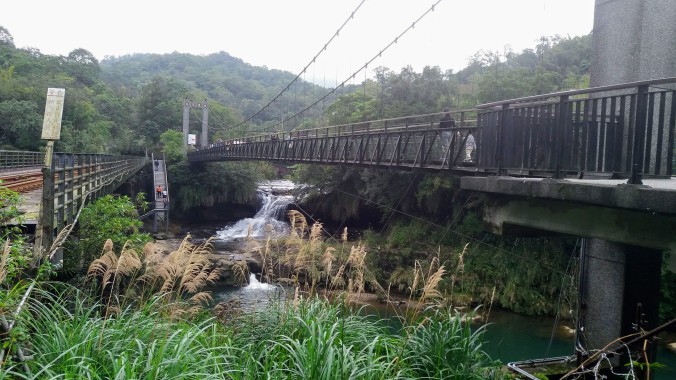
I felt a little like I was playing tag with the scenery. I just about had time to get there take some pics, stare longingly at the cool water for a couple minutes and hike back to the bus. There is nothing “cold” about winter in Taipei. I saw pictures online of people in the snow, but I think it must be a real rarity. Locals did tell me the weather on my visit was unseasonably warm, but rushing around the geopark and speeding through the countryside to see the waterfall had me soaked in sweat.

Nonetheless, it is a remarkable waterfall. No mere trickle through the rocks as far too many advertised waterfalls can turn out to be, this was a broad and strong roaring fall. If you are lucky enough to have more than 20 minutes here, there are also several restaurants and picnic tables where you can enjoy the waterfall over lunch.
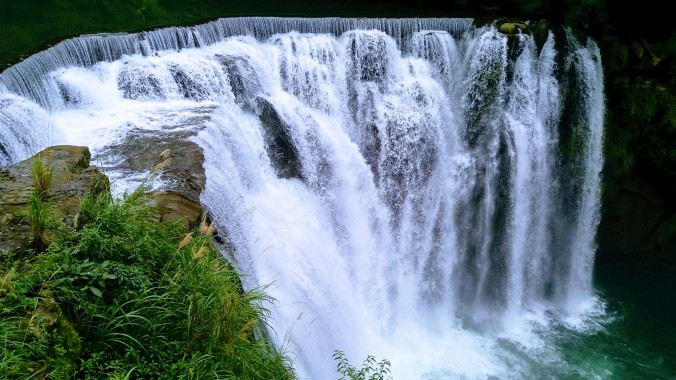
Kaohsiung:
I actually only included Kaohsiung in my travel plans after I read that one of the only sites of mass butterfly migration was near there and was going to be happening during January (when I was traveling). Like waterfalls, butterflies are an irresistible draw for me. I do enjoy a butterfly park, where many species are raised for ecological conservation or just because they’re pretty, and visitors can walk through a mesh enclosed garden to see them, but I also treasure butterflies in the wild. It always feels like a tiny little brush with magic when they pose for me.
Maolin Butterfly Trail 茂林賞蝶步道
Thus, when I read about the mass migration of the purple crow butterflies I was very excited. There are only two species in the world that overwinter en masse in a valley like this, and the other is the monarch. I’d seen beautiful footage of the monarch masses in Mexico (not open to tourists, btw, to protect the butterflies) and while the articles I read warned me not to expect anything so profuse, it is still the second largest natural gathering of butterflies in the world. I had to go.
I did a lot of research to prepare. Optimal butterfly viewing is 8-11am, but the buses don’t run that early. I actually emailed with the park about this. The best public transit option from Kaohsiung is to take Kaohsiung Bus E25 & E28 (Kaoqi Express) to Qishan and then change to H31 (Qishan-Maolin-Duona) (website link) The problem is the distance and time. The E25 takes just over 3 hours, and then you wait for one of the 6 daily buses to Maolin park entrance and ride another 45-60 minutes. Both E25&28 don’t run before 7am. Nothing gets you to Qishan early enough to reach the park entrance before noon. I also looked into hostel, b&bs or other options closer to the park, but even searching in Chinese with my not entirely terrible language skills, information was scarce. The few places I found online couldn’t take reservations online and were not on the shuttle bus route in any case.
To make matters even more complicated, there was an earthquake in 2005 which decimated a lot of that area, but there’s not a lot of information on what is or isn’t still functional post quake.
I could have just bused in and arrived at noon, and taken my chances the butterflies were not all having their afternoon nap, but I wanted masses of butterflies. I looked at videos as recently as two days before my arrival in Kaohsiung and saw them fluttering all over the roads. In some places, roads were even being shut down to protect the butterflies! So, I booked myself a car to drive me there at the very crack of dawn. I used a company called Tripool, and instead of a 4-5 hour bus trip for 5$, I had a 1 hour car ride for 35$. If it had worked as planned, I still say it would have been worth it.
I had been watching the weather forecast like a hawk, but it was barely reliable in the city and there was next to no data about the mountains. Several days of weather patterns led me to hope that a gray misty early morning would burn off into a sunny mid-morning, so I bundled myself in the car at 7am and headed to the Taiwanese countryside.
When I arrived, the weather was still terrible. The car I hired dropped me off here.
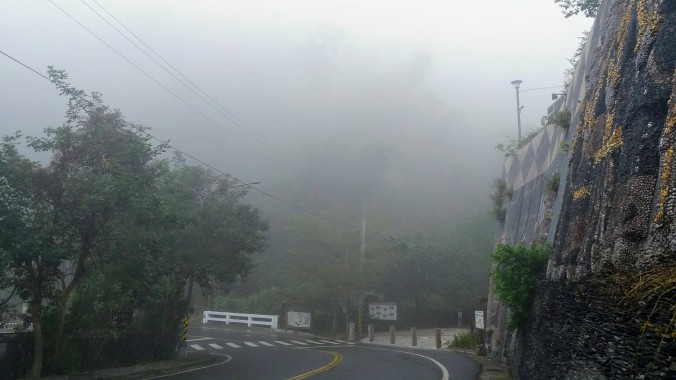
I found what looked like the trail head which had lots of signs about trails and how to spot the butterflies, but they were old and dirty, like no one had used them in years. You don’t know how unsettling it is to be in this kind of fog filled emptiness and see signs that are obviously new (it has a QR code for heavens-sake) but look like they’re from some kind of post-apocalyptic survival film.

It turns out the reason is that no one HAD used them in years. The original structures from before the earthquake had just been abandoned. Eventually, I found the actual visitors center, which made me feel a lot better. The people there said there wouldn’t be any butterfly activity that day, but the weather outlook for the rest of my time in Taiwan didn’t look any better. Plus, it was 4 hours until the next bus out of town.
I watched a movie about the butterflies with a group of school children on a school educational trip. I didn’t understand that much, but it was mostly fun to watch the kids react to the video (and to me). After that, I decided to hike the trail despite the weather.
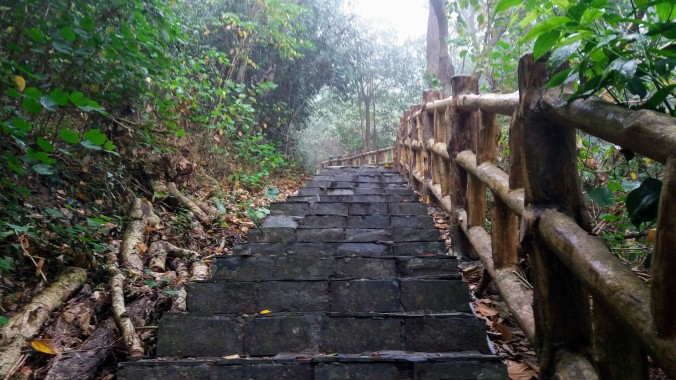
I climbed stairs for hours and saw zero signs of butterfly presence. My photos from the hike look like they should be eerily silent, but the music from the cafe could be heard pretty much all over the trail, and despite the terrible weather, there were a significant number of other tourists out here chattering away.
Although I found no butterflies for most of my hiking time, I did find plenty of interesting things. There were adorable snails who thought the rainy atmosphere was perfect. There were beautiful tropical flowers, flourishing in the warm winter air. And, there was an army of giant spiders. I experienced the summer spiders in mainland China, and to a lesser extent in Korea. These are monsters who build webs that are several meters across. I am not kidding or exaggerating. These suckers are like 5cm not counting legs.
Honestly, I rarely see them quite that big in Korea… at least in the cities, and they are really good about not ever coming inside houses, and about building their webs where people aren’t likely to walk. I don’t think they’re considerate, just that it’s a lot of effort to make an enormous web, and they don’t want us to smash it.
The spiders in Maolin think 5cm body length is scrawny. If I was not familiar with the species behavior, I would have totally freaked out. Luckily I know from experience, they are not interested in me. They don’t want to put a web across a path. They will not drop on you from above. That last one is really relevant since, to avoid the humans, a lot of them just built their webs about 10ft up. Where they can catch birds.
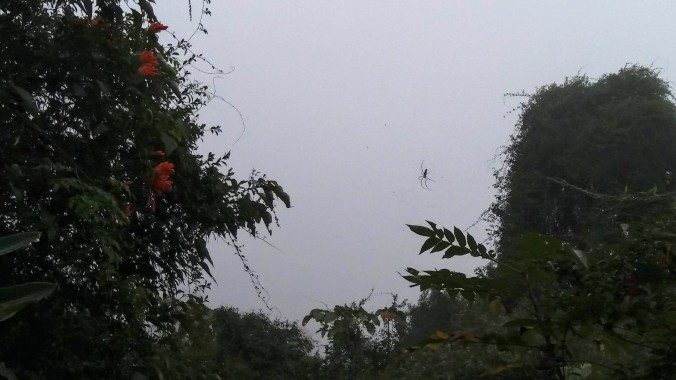
To be honest, I was really surprised there were no butterfly corpses in these webs. And, however intimidating these spiders can look, the webs in the mist and rain were beautiful jeweled works of art.
After a couple hours of meandering, I finally found some butterflies. I saw maybe 20-30 the whole day, and only one close enough to photo. It was a far cry from the hundreds or thousands I had been hoping to see.
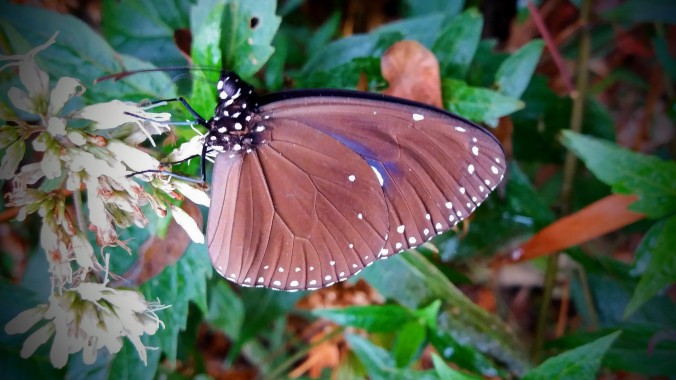
It is awfully beautiful there, but I really wish I could have seen it in action. Just in case the Taiwanese government was exaggerating, I did check the live video feed and some Instagram filters from sunnier days, and it looks like it really is a little fairy land. Next time, I will have to watch the weather more carefully and be ready to rush to Kaohsiung at short notice. The good news is, it’s only a couple hours from Taipei to Kaohsiung, so I won’t have to stay there waiting (Taipei has better food, sorry Kaohsiung), but I will have to have a more flexible plan.
Temples
Taoism (pinyin: Daoism), Confucianism and Buddhism are considered the three main “religions” of China. Taoism is mainly a mix of local folk practices that consolidated after the introduction of Buddhism. It has a LOT of gods and spirits and ancestors and immortals and magic animals. The main goal of Taoism is immortality (although there is a split on whether that means corporeal or spiritual), but you can pray to any of the gods for help with more mundane stuff like health, marriage, or passing your driving test.
Buddhism, often heard of but rarely understood, is a spiritual practice without any gods. Buddhists search for Enlightenment and subsequent freedom from this world which is both an illusion and full of suffering. This takes a few hundred (thousand) lifetimes, so in the mean time a lot of people pray to the boddhisattvas (a little like saints?) for the same mundane stuff they ask the Taoist gods for.
Confucianism is more a total package social structure than a “religion” but it does incorporate a certain amount of ritual and spirit oriented behavior and a very clear “how to live” guide, though not a lot of praying for mundane stuff. To be even further removed from the Western traditions, a lot of people don’t choose just one, but rather go to whichever will serve an specific purpose at a time. They simply aren’t viewed as exclusive “truths”. Honestly, almost nothing we associate with “religion” in the western traditions applies to any of these, but until we have a better word, here we are.
Taipei:
Dadaocheng Cisheng Temple 大稻埕慈聖宮天上聖母 (Taoist) is dedicated to the Tianshang Shengmu (Heavenly Holy Mother), the guardian of sailors and also known as Mazu or Tianhou (Empress of Heaven). It is in the midst of an “eat street” and even has a dining area in the temple courtyard. Far from being serene and heavenly, it is quite lively and bustling.
Taipei Confucius Temple 臺北市孔廟 is more of an interactive educational experience than a holy place. It’s not surprising as Confucianism isn’t really a religion. The scholar Confucius (Kongfuzi 孔夫子) was more interested in the smooth running of things on the earthly plane than the spiritual one. Rituals were an important part of a social order for him, but he didn’t spend much time speculating on any gods or spirits.
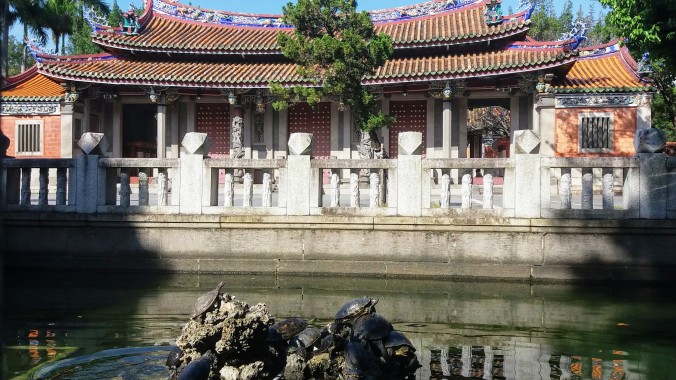
The entire compound is beautiful, but more that that, you get a wonderful English language detailed explanation of the meaning and purpose of each hall (which, under other circumstances I might have transcribed off the brochure, but I feel like you’ve had enough education for one post), a truly early-tech 3D film explaining the history of Confucianism and it’s modern interpretation (it was so campy it was fun) and interactive displays for the six Confucian Arts that Confucius considered vital for any civilized person in a civilized society: Calligraphy, Music, Archery, Charioteering, Computation (math), and Rites (religious, political, and social ceremonies).
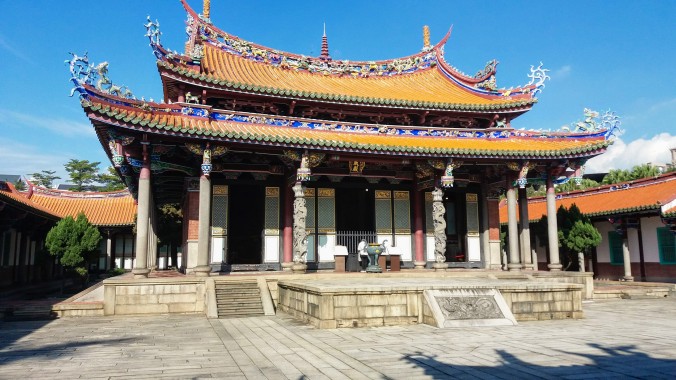
It was a big contrast to the Confucian temple I visited in Beijing which was a beautiful monument with little to no explanation as to it’s historical function. Plus, where Taiwan still teaches pieces of the 6 arts in schools and even holds some public Confucian rites today, the mainland has subsumed Confucian values into the Communist Party Line.

Dalongdong Baoan Temple 大龍峒保安宮 (Taoist) is dedicated to Baosheng Dadi (Great Emperor Protecting Life). It claims to be the oldest temple in Taiwan, or at least the oldest Chinese temple. (Yes, there were indigenous people living in Taiwan before the Han ethnicity mainland Chinese people arrived many centuries ago). It’s been restored many times over the years and is now an important heritage site. There’s several stunningly decorated buildings, as well as beautiful gardens with statues of famous Taoist stories, and a dragon in the lake. I especially enjoyed the tile work of the roof dragons on these temples which is distinct in both color and style from the mainland.
Kaohsiung:
Fo Guang Shan Buddha Museum 佛光山佛陀紀念館 was disturbingly hard to get to, but thankfully I can read bus timetables in Chinese. It probably would have been easier if I’d been coming direct from the city, but I was coming on my way back from the Maolin Butterfly Park. I also missed the last buses returning to the city, but it was ok because I was able to share a car with some other travelers. I don’t think it’s necessary to do this with a tour company, but if you aren’t at least “survival” level in Mandarin, then perhaps plan better than I did.

Fo Guang Shan is a global sect of Buddhism which started there in Taiwan at the largest monastery in Taiwan. It really is huge, and not only the enormous statue of the Buddha, but the sprawling grounds filled with gardens, exotic birds, and more beautiful statues than you can count.
The grounds are divided reflect the three treasures: sangha (community) where the monks and nuns live, study and work; dharma (teachings) where scriptures (sutras) are housed and ceremonies held; and the Buddha (the teacher) where the famously enormous statue rests at the end of the majestic walkway.


I think most people come for the third part, and honestly, that’s why I was there. I just took a “wrong” turn at the entrance and found myself walking all the way over to the Sangha, and then meandering back through the Dharma, before finally getting to the Buddha in time to for most of the tourists to leave and for the lights to come on.
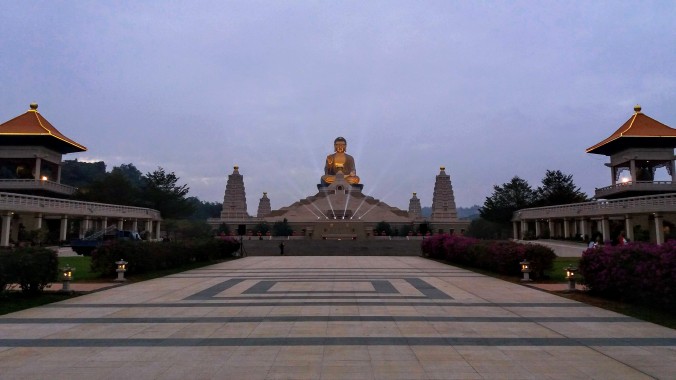
Their website is everything you would expect elderly monks to have created, but if you want to learn more about Fo Guang you can visit. Also, the museum’s website reflects a more worldly involvement and may be more palatable to the modern internet consumer as well as more helpful to the hopeful visitor.
That’s all for part 1. Thanks for reading! I hope you enjoyed the historical and natural side of my Taiwan trip. Next time, I’ll write about the more modern aspects including the “old streets” for tourists, a medieval style castle made by an eccentric millionaire, flowers, light shows, street art, and of course what Taiwan is best known for: the food.























